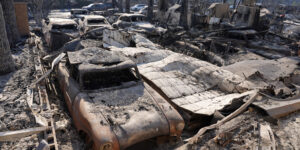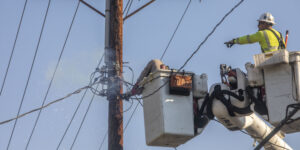Hurricane Idalia came ashore on Florida’s west coast with destructive Category 3 winds, triggering blackouts and unleashing flooding rains and dangerous storm surge.
Idalia’s maximum sustained winds reached 125 miles (201 kilometers) per hour Wednesday as it slammed into the sparsely populated Big Bend region, the U.S. National Hurricane Center said in an update at 7:45 a.m. Eastern time.
The hurricane was located about 55 miles north of Cedar Key as the storm crawls north-northeast. It’s expected to move along the coast of the Southeast U.S. after crossing Florida.
“While Idalia should weaken after landfall, it is likely to still be a hurricane while moving across southern Georgia, and near the coast of Georgia or southern South Carolina late today,” the hurricane center said in an earlier update.
As much as 16 feet (4.9 meters) of sea water could be pushed onshore in some areas on the Gulf Coast, and 6 feet could slosh across Tampa Bay. The storm is struck north of heavily populated areas near Tampa and Clearwater.
Idalia will likely maintain hurricane winds further north into Georgia, which will increase power outages, said Anthony Chipriano, a meteorologist with Maxar. As of 7:15 a.m. local time, some 107,056 customers were without power in Florida, according to website Poweroutage.us.
Tampa International Airport was closed due to the storm. More than 500 flights in and out of Florida airports were canceled as of early Wednesday, according to data from FlightAware. Almost 100 were canceled to and from Atlanta, a major U.S. transportation hub.
Idalia is the first major hurricane to hit Florida since last September. That’s when Hurricane Ian struck the western part of the state as a Category 4 storm, killing at least 150 people and causing more than $112 billion in damage.
The latest hurricane is likely a solid $10 billion storm in terms of damages and losses, according to Chuck Watson, at Enki Research. The storm is hitting sparsely populated area and that will keep damages down, but what is in its path—including people—will be in danger.
Featured image: TARPON SPRINGS, FLORIDA – AUGUST 30: Reporters wade through flood waters as it inundates the downtown area after Hurricane Idalia passed offshore on August 30, 2023 in Tarpon Springs, Florida. Hurricane Idalia is hitting the Big Bend area of Florida. (Photo by Joe Raedle/Getty Images)





















 First 2025 Atlantic Hurricane Season Forecasts 7 Named Storms
First 2025 Atlantic Hurricane Season Forecasts 7 Named Storms  Four P/C Insurers Are ‘AI Titans’; AI Impact Leaders Revealed: Research
Four P/C Insurers Are ‘AI Titans’; AI Impact Leaders Revealed: Research  NWS Preliminary Estimate for 2024: More Than 5,300 Hail Events, 1,855 Tornadoes
NWS Preliminary Estimate for 2024: More Than 5,300 Hail Events, 1,855 Tornadoes  Musk’s Massive Tesla Lithium Plant Hunts for Water in Drought-Hit Texas
Musk’s Massive Tesla Lithium Plant Hunts for Water in Drought-Hit Texas 




